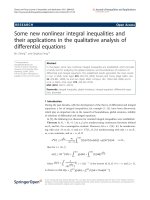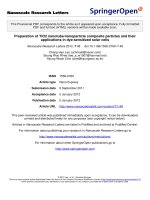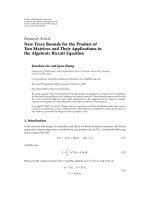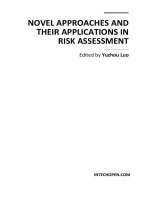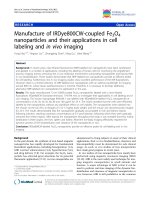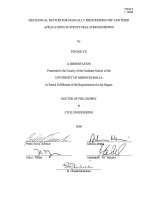Functional cellulose derivatives and their applications in food and pharmaceutical products
Bạn đang xem bản rút gọn của tài liệu. Xem và tải ngay bản đầy đủ của tài liệu tại đây (4.02 MB, 146 trang )
FUNCTIONAL CELLULOSE DERIVATIVES AND THEIR
APPLICATIONS IN FOOD AND PHARMACEUTICAL
PRODUCTS
LILIA BRUNO
( B.Tech, Biotechnology, VIT )
A THESIS SUBMITTED FOR THE DEGREE OF DOCTOR OF
PHILOSOPHY
DEPARTMENT OF CHEMISTRY
NATIONAL UNIVERSITY OF SINGAPORE
2011
i
ACKNOWLEDGMENTS
I wish to express my heartfelt gratitude to my supervisors, Senior Lecturer Dr. Leong Lai
Peng, Associate Professor Paul Heng Wan Sia and Professor Stefan Kasapis for their advice
and guidance throughout the course of my PhD candidature.
My warm thanks to all the laboratory staff of the food science and technology program,
Department of Chemistry and the Department of Pharmacy for their technical assistance
especially Chooi Lan and Huey Lee.
I wish to thank my friends and fellow graduate students, Jiang Bin, Preeti, Lee Wah and Shen
Siung for their help and encouragement and most importantly for making my graduate life
memorable.
Last but not least, I wish to thank my parents without whose support, guidance and love I
would not have come this far.
ii
TABLE OF CONTENTS
ACKNOWLEDGEMENTS
i
TABLE OF CONTENTS
ii
SUMMARY
vii
LIST OF TABLES
ix
LIST OF FIGURES
x
LIST OF ABBREVIATIONS AND SYMBOLS
LIST OF EQUATIONS
CHAPTER 1. INTRODUCTION
1.1. Drug Delivery
1.2. The Skin
1.3. Topical Drug Delivery
1.4. Transdermal Drug Delivery
1.5. Merits and Disadvantages of Dermal Delivery
1.6. Gel
1.7. Non aqueous gel
1.8. Ethyl Cellulose
1.9. Propylene glycol Dicaprylate/Dicaprate
1.10 . Dynamic Rheology
1.10.1. Strain/Stress Sweep Tests
1.10.2. Frequency Sweep Tests
1.10.3. Temperature Sweep Tests
xiv
xvi
1
1
2
2
3
3
4
5
6
6
8
9
10
10
iii
1.10.4. Time Sweep Tests
1.10.5. Time Temperature Superposition (TTS)
1.11 Attenuated Total Reflectance Fourier Transform
Infrared Spectroscopy (ATR FTIR)
1.12 Differential Scanning Calorimetry (DSC)
1.13 X Ray Diffraction
1.14 Optical Profile Analysis
1.15
2
H Nuclear Magnetic Resonance (NMR)
References
CHAPTER 2. LITERATURE REVIEW
2.1. Non aqueous systems in medical applications
2.2. Non aqueous systems comprising Ethyl Cellulose
References
CHAPTER 3. STRUCTURAL PROPERTIES OF NON AQUEOUS
ETHYL CELLULOSE SYSTEMS INTENDED FOR TOPICAL DRUG
DELIVERY
3.1. Introduction
3.2. Materials and Methods
3.2.1. Materials
3.2.2. Gel preparation
3.2.3. Rheological Measurements
3.2.4. Thermal Analysis
3.2.5. X ray diffraction studies
3.2.6. ATR FTIR analysis
3.2.7. Optical Profile analysis
11
11
12
13
14
15
16
17
20
20
22
27
30
31
33
33
34
34
34
35
35
35
iv
3.3. Results and discussion
3.3.1. Temperature course of mechanical properties in ethyl
cellulose/Propylene glycol Dicaprylate/dicaprate mixtures
3.3.2. Time course of structural properties in ethyl cellulose/
Propylene glycol Dicaprylate/dicaprate mixtures
3.3.3. Molecular interactions in Ethyl cellulose/ propylene
glycol dicaprylate mixtures
3.4. Conclusions
References
CHAPTER 4. EFFECT OF HYDRATION ON THE STRUCTURAL
PROPERTIES OF NON AQUEOUS ETHYL CELLULOSE GELS
4.1. Introduction
4.2. Materials and Methods
4.2.1. Materials
4.2.2. Gel Preparation
4.2.3. Rheological Measurements
4.2.4. Thermal Analysis
4.2.5.
2
H NMR spectroscopy
4.2.6. ATR FTIR analysis
4.2.7. Light Microscopy
4.2.8. X ray diffraction studies
4.3. Results and Discussion
4.3.1. Rheological Analysis
4.3.2. Thermal Analysis
4.3.3.
2
H NMR spectra analysis
36
36
45
48
54
57
61
62
64
64
64
65
65
66
66
67
67
68
68
72
75
v
4.3.4. ATR FTIR analysis
4.3.5. Light Microscopy
4.3.6. X ray diffraction patterns
4.4. Conclusions
References
CHAPTER 5. EFFECT OF POLYMER MOLECULAR WEIGHT ON
THE STRUCTURAL PROPERTIES OF NON AQUEOUS ETHYL
CELLULOSE GELS
5.1. Introduction
5.2. Materials and methods
5.2.1. Materials
5.2.2. Gel preparation
5.2.3. Rheological measurements
5.2.4. ATR FTIR analysis
5.2.5. X ray diffraction studies
5.3. Results and discussion
5.3.1. Frequency dependence of the gels
5.3.2. Effect of thermal treatment on the gels
5.3.3. Determination of the critical gelation temperature
5.3.4. The relaxation exponent and fractal dimension of
EC/PGD gels
5.3.5. X ray diffraction studies of the different molecular
weight gels
5.3.6. ATR FTIR studies
5.4. Conclusion
80
83
85
87
88
92
93
95
95
95
96
96
96
97
97
99
104
111
114
117
118
vi
References
CONCLUSIONS AND FUTURE WORK
LIST OF PUBLICATIONS AND PRESENTATIONS
120
123
127
vii
vii
SUMMARY
The limited information available on non aqueous drug delivery systems warrants more in
depth study on the structural properties of one such system comprising of ethyl cellulose (EC)
and a non aqueous solvent, propylene glycol dicaprylate (PGD).
The working protocol included small-deformation dynamic oscillation in combination with
the principle of time–temperature superposition, micro and modulated differential scanning
calorimetry, light microscopy, wide-angle X-ray diffraction patterns, infrared spectroscopy,
optical profile analysis in the form of gel particle roughness and
2
H-NMR spectroscopy.
The first part of this work focuses on the effect of time and temperature on the structural
properties of the non aqueous EC system. It was seen that when PGD was mixed with EC,
gels that revert to the solution state with increasing temperature were formed which is in
contrast with the thermogelation seen for EC / water solutions. Time effects were also
probed; the continuous increase in viscoelasticity of preparations as a function of time of
observation at ambient temperature was accompanied by structural disintegration of the
polymeric particles. This was rationalized by proposing that specific polymer–solvent
interactions result with aging in particle erosion and the release of polymeric strands that are
able to form a three-dimensional structure.
The next part of this work focuses on the effect of moisture on the structural properties of the
gel system. Although designed to be a non-aqueous vehicle for moisture sensitive drugs,
EC/PGD systems are expected to experience an aqueous environment during production,
storage and application on the skin. Hence, the interaction of water with the non aqueous gel
system and its distribution within the gel network is of great interest and critical to its
application. Rheological profiles of the gels containing moisture (0.5 to 45.0 % w/w)
deviated considerably from that of the non aqueous system at levels of water above 10.0 % in
viii
preparations. Gradual replacement of the dipole interactions between polymer and solvent
with stronger intramolecular hydrogen bonding within the EC chains as the level of hydration
increased was behind these observations. X-ray diffraction patterns showed that the
rearrangement of the polymer chains led to the loss of the cholesteric liquid crystalline
structures found in the anhydrous gel. DSC and
2
H-NMR studies shed light on the state of
added water in the gels. Plots of enthalpy obtained calorimetrically and a good correlation
between DSC and
2
H-NMR data indicate that gels with less than two percent hydration
contain water in a non-freezable bound state, whereas freezable moieties are obtained at
levels of hydration above five percent in composite gels.
The last part of this work focuses on the effect of polymer molecular weight on the structural
properties of the system. Previous studies show that polymer chain length plays a significant
role in the mechanical and viscoelastic properties of gel systems. This compelled us to
investigate the effect of polymer chain length on gelation and thermal properties of the gel
system. The frequency sweep data of the heated gels show that the higher molecular weight
gels show good rheological properties for the intended use of the system. The Winters and
Chambon method was used to determine the gel point of the gels of different molecular
weight and concentration. In addition, the critical exponent and the fractal dimension of the
gels were determined. The critical exponent values were found to be between 0.45 to 0.38
whereas the fractal dimension values were found to be consistent over the range of molecular
weights tested and the value suggests the formation of a compact homogenous network.
Material characterization by X ray diffraction studies and ATR FTIR reflected the changes in
the gel structuring and bonding with changes in the polymer molecular weight.
ix
LIST OF TABLES
Table 5.1
M
W
values of the different polymer grades used in the
study
95
Table 5.2
The T
gel
values for the EC/PGD gels of different molecular
weights and concentrations
108
x
LIST OF FIGURES
Figure 1.1
Structure of Ethyl cellulose
7
Figure 1.2
Molecular structures of (a) propylene glycol dicaprylate
and (b) dicaprate.
7
Figure 3.1
Strain sweep measurement for LVR determination of
freshly prepared 12%EC/PGD gel at 25°C. ( Frequency:
1rad/s)
37
Figure 3.2
Frequency dependence of freshly prepared 12%EC/PGD
gel. (strain: 0.5%)
38
Figure 3.3
Elastic modulus (a) and tan (b) obtained from controlled
heating (closed symbols) and cooling (open symbols) at a
rate of 1ºC/min on 12% fresh EC/PGD gel - first
temperature sweep (; ), second temperature sweep
following isothermal aging at 25ºC for 48 hours (; ),
and third temperature sweep (; ) following another
isothermal aging period at 25ºC for 48 hours (frequency:
1 rad/s; strain: 0.5%).
39
Figure 3.4
Frequency variation of G' (a) and G" (b) of a freshly
made 12% EC gel in PGD at 5 (), 0 (), - 5 (), - 10
(), - 15 (), - 20 (), and - 25ºC ().
41
Figure 3.5
( a) Composite curve of reduced shear moduli ((G'
p
();
G"
p
()) for the sample of Figure 3 at the reference
temperature of - 25°C, and (b) temperature variation of
the factor a
T
for the rubbery region () of the sample,
with the solid line reflecting the modified Arrhenius fit.
43
Figure 3.6
Root mean square roughness (R
q
) of the fresh () and
heated () 12% EC/PGD gel with respect to a time scale.
46
Figure 3.7
Variation of storage modulus, loss modulus and tan as a
function of time at 25°C for 12% EC/PGD gel
(frequency: 1 rad/s; strain: 0.5%).
47
xi
Figure 3.8
Wide angle X-ray diffraction patterns for (a) ethyl
cellulose powder (b) freshly made gel of 12% EC in PGD
(c) 12% EC/PGD gel undergone prior thermal treatment.
49
Figure 3.9
FTIR spectrum of (a) ethyl cellulose powder (b) freshly
made gel of 12% EC in PGD (c) 12% EC/PGD gel
undergone prior thermal treatment.
51
Figure 3.10
(a) Micro DSC heating and cooling thermograms obtained
at a scan rate of 1˚C/min for 12% EC/PGD gel, and (b)
Modulated DSC cooling scans of 12% EC/PGD gel or
PGD solvent taken at a scan rate of 5°C/min.
53
Figure 3.11
Mechanistic depiction of the two molecular processes
governing the structural properties of ethylcellulose /
propylene glycol dicaprylate/dicaprate gel as a function
of time at ambient temperature.
54
Figure 4.1
Frequency variation of shear storage modulus (a) and
shear loss modulus (b) of 12% EC/PGD gel with varying
amounts of moisture; 0% (●), 0.1% (◆), 0.5% (■),1%
(□), 5% (◇), 10% (), 15% (), 20% (), 30% (×)
and 40% (-).
69
Figure 4.2
Controlled heating and cooling at 1°C/min, as indicated
by the arrows, of the shear storage modulus (a) and tan
delta (b) for 12% EC/PGD gels having relatively low
levels of moisture in comparison to the anhydrous gel
[anhydrous gel (◆), 0.1% (), 0.5% (□), 1% (◇) and
5% () water], and the shear storage modulus (c) and tan
delta (d) for 12% EC/PGD gels having relatively high
levels of moisture in comparison to the anhydrous gel
[anhydrous gel (◆), 10% (□), 20% (), 30% (◇) and
40% () water].
71
Figure 4.3
(a) Ice formation peaks observed during DSC cooling
cycles for the 12% EC/PGD gel at water levels shown by
the individual traces, and (b) DSC scans for 12% EC/PGD
gel containing 30% water showing a single crystallization
peak (top thermogram) and a melting endotherm at
around 0°C (scan rate: 5°C/min).
73
Figure 4.4
Effect of water content (% w/w) on the melting enthalpy
of 12% EC/PGD gels extrapolated to zero enthalpy
through the line of best fit.
74


